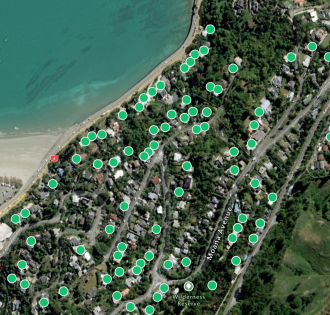At the Natural Hazards Commission Toka Tū Ake we work to reduce risk from natural hazards in New Zealand. Our goal is to inform, enable, and influence evidence-based risk reduction decision-making and action.
Natural hazards are a normal process of nature. When they interact with the things we value, they become risks. These risks can cause impacts including property damage, social and economic disruption, and damage to the natural environment. In the worst cases, they may result in injury or loss of life.
We collaborate and provide expertise across the public and private sectors to promote natural hazard risk reduction. We do this by translating, sharing, contributing, leading, and supporting in data and information, policy and governance and thought leadership.
You can contact us about our risk reduction work at resilience@naturalhazards.govt.nz.
Our risk reduction work includes:
- helping to design policies, regulations and guidance through engagement, and submissions on consultation documents
- engaging with the natural hazard risk and resilience sector to support decisions that increase resilience to natural hazards at the national, regional and local levels in New Zealand
- identifying research gaps, and
- supporting public education campaigns.
Read more about the work we do below:
- Natural Hazards Portal
- Submissions
- Smarter Land Use Action Plan
- Resilient Homes and Building Action Plan
- Design Resilience NZ
- Risk Tolerance

Natural Hazards Portal

The Natural Hazards Portal is a tool you can use to explore New Zealand’s natural hazard risk. You can see how previous events have impacted a property by looking at past Natural Hazards Commission claims, and find out what you can do. Use the portal to:
- improve your awareness about natural hazard risk
- understand how natural hazard events may impact you, your home, and your community
- explore where natural hazard events have occurred in New Zealand before
- consider the actions you want to take to manage risk and build resilience.
Visit the Natural Hazards Portal(external link).
Submissions
The Natural Hazards Commission Toka Tū Ake regularly submits on central government policy changes and local and regional plan changes. We do this to encourage these policies to reduce or manage natural hazard risks to communities and homes, and to take a resilient, sustainable approach to development generally.
Our submissions are supported by robust natural hazard risk science, mapping, and data. If you would like to discuss any of our submissions with us, please contact us at resilience@naturalhazards.govt.nz.
You can view our past submissions here(external link).
Smarter Land Use Action Plan
 The result of our resilience goal will be stronger homes, built on better land.
The result of our resilience goal will be stronger homes, built on better land.
To help reach this goal, we have developed a Smarter Land Use Action Plan.
Our land use planning goal is to take a proactive approach to reduce our current and future risks through smarter, risk-based, land use planning.
The Smarter Land Use Action Plan has the following objectives:
- Provide leadership in land use planning for natural hazard risk reduction.
- Encourage and support risk-based planning solutions based on knowledges and understandings.
- Build capability and capacity to reduce risks over time.
Read the Smarter Land Use Action Plan.
Resilient Homes and Buildings Action Plan
The result of our resilience goal will be stronger homes, built on better land. 
To help reach this goal, we have developed a Resilient Homes and Buildings Action Plan.
Our Resilient Homes and Buildings Goal is to increase the resilience of homes and buildings for the safety and wellbeing of all those in New Zealand.
The Resilient Homes and Buildings Action Plan has the following objectives:
- New homes and buildings are designed and built for resilience.
- Existing buildings are assessed and managed, so they are safe and resilient.
- New Zealand’s built environment ‘system’ is enduring and fit for purpose.
Read the Resilient Homes and Buildings Action Plan
Design Resilience NZ
Design.Resilience.NZ(external link) is a website that provides access to a range of building design and construction resources for practitioners, designers, building consent authorities, builders, and building owners or users.
The site provides non-regulatory materials targeting ‘above code’ building performance. It promotes the implementation of design that meets the needs and expectations of building owners and users. It aims to raise the resilience of the built environment of New Zealand.
This site is a joint venture between the Building Research Association of New Zealand (BRANZ), the Ministry of Business, Innovation & Employment, the Natural Hazards Commission Toka Tū Ake, the New Zealand Geotechnical Society, the New Zealand Society for Earthquake Engineering, and Structural Engineering Society New Zealand.
Visit Design.Resilience.NZ(external link)
Risk Tolerance
Risk tolerance is the willingness to bear a risk. Understanding risk tolerance helps us decide how to manage the potential impacts of a hazard on the things we value (such as our health, environment, economy, and buildings and infrastructure).
The Risk Tolerance Methodology and Natural Hazard Risk Tolerance Literature Review seek to fill a critical gap in New Zealand’s well-established hazard risk management approaches.
Read the Risk tolerance methodology.
Read the Natural hazard risk tolerance literature review.